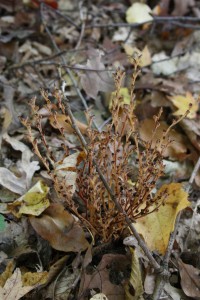I wrote this for the community at school- on Oct 9, 2012,
photo from Wikipedia commons, taken by Cody Hough
Monday morning I was walking along the driveway loop overlooking the marsh restoration and parking lot when something caught my eye. A fine mist rose from a bed of ochre mulch and yellow pine needles, forming a shimmering haze as I looked toward the parking lot. Sunlight dappled through the leaves of beech and oak, through the boughs of pine, landing on a rock here, a pine bed there, a scattered clump of what looked like dry weeds throughout the otherwise groomed embankment.
These plants caught my eye and might catch yours if you walked by. They are not weeds and neither are they dried and dead, but rather, living and one of the most interesting features of New England forests. In the fall, when leaves blaze, a texture of browns emerges in the understory. As you looked, you might see a shape emerge from the mottled background- tan stems and flowers, with slight reddish brown edges, hiding in plain sight. It is no fungus, although you might be easily confused by their pallor. In fact, they, as all flowering plants, produce pollen and eggs and reproduce with seeds.
These are beech drops (Epifagus virginana), one of a few species of parasitic flowering plants that have lost most of their chlorophyll and survive by taking nutrients from other plants, in this case, the roots of beech trees. Their lovely tube-like flowers, out between August and October, would not be noticed by anyone looking for showy blooms, but they are one of the quiet, wonderful parts of the world we share.
I hope you enjoy walk along the driveway loop, on this overcast fall day. Look toward the parking lot, and see something neat on the hill.

